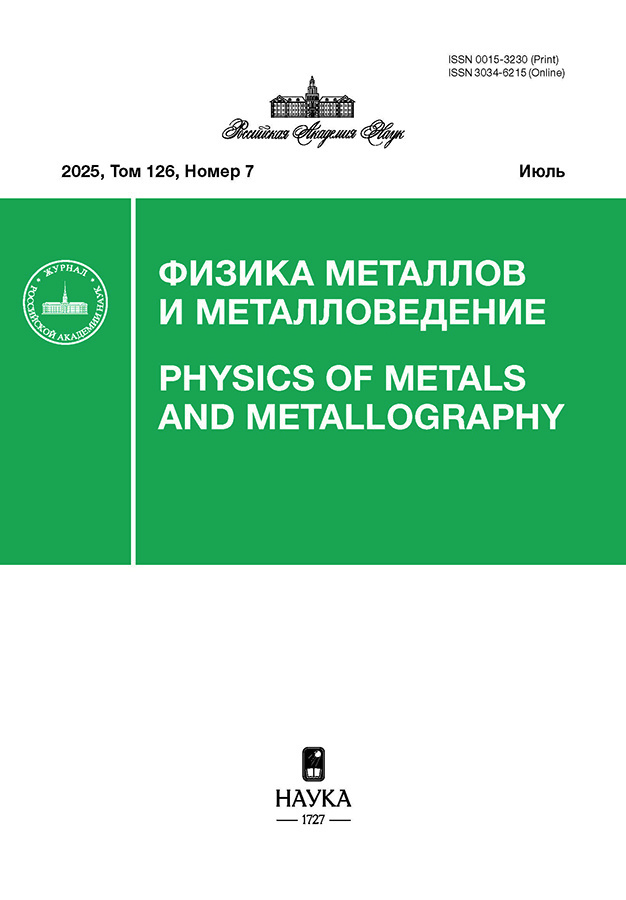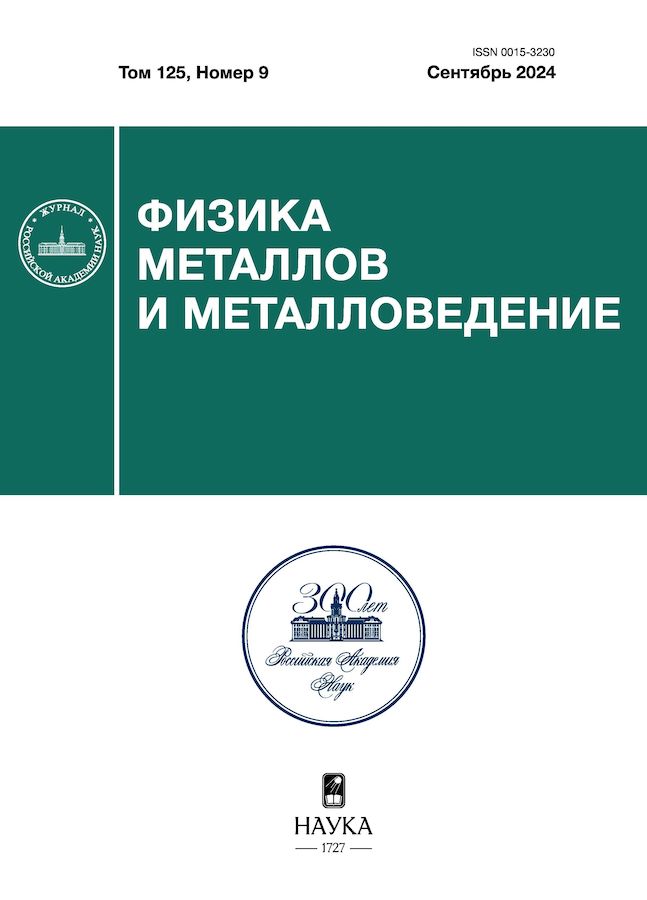Расчет пороговых энергий смещения в коррозионностойких аустенитных сталях
- Авторы: Воскобойников Р.Е.1,2
-
Учреждения:
- Национальный исследовательский ядерный университет “МИФИ”
- Национальный исследовательский центр “Курчатовский институт”
- Выпуск: Том 125, № 9 (2024)
- Страницы: 1100-1107
- Раздел: СТРУКТУРА, ФАЗОВЫЕ ПРЕВРАЩЕНИЯ И ДИФФУЗИЯ
- URL: https://rjdentistry.com/0015-3230/article/view/677432
- DOI: https://doi.org/10.31857/S0015323024090051
- EDN: https://elibrary.ru/KEYGOQ
- ID: 677432
Цитировать
Полный текст
Аннотация
Методом молекулярной динамики (МД) смоделировано первичное дефектообразование в ГЦК-модельном сплаве на основе Fe–Cr–Ni, химический состав которого совпадает с концентрацией трех основных компонентов в коррозионностойких аустенитных сталях типа Х18Н10. Сгенерированная выборка, включающая в себя 12 960 событий образования радиационных дефектов, инициированных первично-выбитыми атомами (ПВА) Fe, Cr и Ni с энергиями 100 эВ ≤EPKA≤ 5 кэВ вдоль пятнадцати неэквивалентных кристаллографических направлений, использована для расчета средних пороговых энергий смещения. Показано, что в исследуемом материале средние пороговые энергии смещения атомов Fe, Cr и Ni совпадают и равны ⟨Ed⟩=28±1 эВ. Полученные данные МД-моделирования использованы для построения зависимости Ed от EPKA, которая распадается на два линейных фрагмента, определяемых механизмом дефектообразования. Определили значение Ecc≈0.8 кэВ, при котором образование изолированных точечных дефектов при низких энергиях ПВА EPKA≤Ecc сменяется дефектообразованием в каскадах столкновений, инициируемых ПВА с энергиями EPKA≥Ecc. На основании полученных результатов МД-моделирования модифицировали каскадную функцию в модели Кинчина–Пиза, чтобы учесть зависимость пороговых энергий смещения Ed от энергии EPKA.
Полный текст
Об авторах
Р. Е. Воскобойников
Национальный исследовательский ядерный университет “МИФИ”; Национальный исследовательский центр “Курчатовский институт”
Автор, ответственный за переписку.
Email: roman.voskoboynikov@gmail.com
Россия, Москва, 115409; Москва, 123182
Список литературы
- Was G.S., Averback R.S. 6.07–Radiation Damage Using Ion Beams, in Konings R.J.M. Eds. Comprehensive Nuclear Materials. Elsevier. 2012. V. 6. P. 195–226.
- Allen T., Busby J., Meyer M., Petti D. Materials challenges for nuclear systems // Materials Today. 2010. V. 13. № 12. P. 14–23.
- Zinkle S.J., Was G.S. Materials challenges in nuclear energy // Acta Mater. 2013. V. 66. № 3. P. 735–758.
- Development of Radiation Resistant Reactor Core Structural Materials, IAEA Scientific Forum 2007 Global Challenges and the Development of Atomic Energy: The Next 25 Years. [Электронный ресурс] https://www.iaea.org/About/Policy/GC/GC51/GC51InfDocuments/English/gc51inf-3-att7_en.pdf (дата обращения: 25.02.2024).
- Cai W., Li J., Uberuaga B.P., Yip S. 1.18 – Molecular Dynamics, in Konings R.J.M. Eds. Comprehensive Nuclear Materials (Second Edition). Elsevier. 2020. V. 1. P. 573–594.
- Nordlund K. Historical review of computer simulation of radiation effects in materials // J. Nucl. Mater. 2019. V. 520. P. 273–295.
- Nordlund K., Zinkle S.J., Sand A.E., Granberg F., Averback R.S., Stoller R.E., Suzudo T., Malerba L., Banhart F., Weber W.J., Willaime F., Dudarev S.L., Simeone D. Primary radiation damage: A review of current understanding and models // J. Nucl. Mater. 2018. V. 512. P. 450–479.
- Ziegler J.F., Biersack J.P. The Stopping and Range of Ions in Matter / in: Bromley D.A. Eds Treatise on Heavy-Ion Science. 1985. Springer, Boston, MA. P. 93–129.
- Ziegler J.F., Biersack J., Littmark U. The Stopping and Range of Ions in Matter 1st ed. Pergamon Press. 1985. 321 p.
- Ziegler J.F. SRIM-2003 // Nucl. Inst. Meth. Phys. Res. B. 2004. V. 219–220. P. 1027–1036.
- Ziegler J.F., Biersack J.P., Ziegler M.D. SRIM–The Stopping Range of Ions in Matter // SRIM Co. 2008. 405 p.
- Ziegler J.F., Ziegler M.D., Biersack J.P. SRIM – The stopping and range of ions in matter // Nucl. Inst. Meth. Phys. Res. B. 2010. V. 268. P. 1818–1823.
- Дистрибутив SRIM-2013 [Электронный ресурс] http://www.srim.org/SRIM/SRIM-2013-Std.e (дата обращения: 25.02.2024).
- Norgett L.K., Robinson M.T., Torrens I.M. A proposed method for calculating displacement dose rates // Nucl. Eng. Design. 1975. V. 33. P. 50–54.
- Voskoboinikov R. Optimal sampling of MD simulations of primary damage formation in collision cascades // Nucl. Inst. Meth. Phys. Res. B. 2020. V. 479. P. 18–22.
- Vladimirov P.V., Borodin V.A. First-principles and classical molecular dynamics study of threshold displacement energy in beryllium // Nucl. Inst. Meth. Phys. Res. B. 2017. V. 393. P. 195–199.
- Stoller R.E., Tamm A., Béland L.K., Samolyuk G.D., Stocks G.M., Caro A., Slipchenko L.V., Osetsky Yu. N., Aabloo A., Klintenberg M., Wang Y. Impact of Short-Range Forces on Defect Production from High-Energy Collisions // J. Chem. Theory Comput. 2016. V. 12:6. P. 2871–2879.
- Daw M.S., Baskes M.I. Embedded-atom method: Derivation and application to impurities, surfaces, and other defects in metals // Phys. Rev. B. 1984. V. 29. P. 6443–6453.
- Allen M.P., Tildesley D.J. Computer Simulation of Liquids. Clarendon, Oxford. 1987. 408 p.
- Lindemann F.A. The calculation of molecular vibration frequencies // Zeitschrift für Physik. 1910. V. 16. P. 609–612.
- Nordlund K., Averback R.S. Point defect movement and annealing in collision cascades// Phys. Rev. B. 1997. V. 56. № 5. P. 2421–2436.
- Wigner-Seitz defect analysis [Электронный ресурс] https://www.ovito.org/docs/current/reference/pipelines/modifiers/wigner_seitz_analysis.html (дата обращения: 25.02.2024).
- Voskoboinikov R.E., Osetsky Yu.N., Bacon D.J. Computer simulation of primary damage creation in displacement cascades in copper. I. Defect creation and cluster statistics // J. Nucl. Mater. 2008. V. 377. P. 385–395.
- Kinchin G.H., Pease R.S. The Displacement of Atoms in Solids by Radiation // Rep. Prog. Phys. 1955. V. 18. P. 1–51.
Дополнительные файлы















